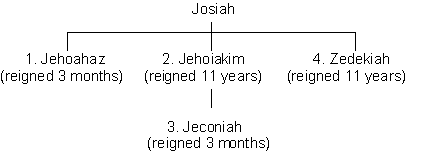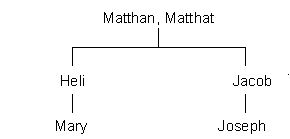


|
1. |
JesusChrist. Here Christ is a name, not a title; cp.
Mk. 1: 1;Jn. 1: 17. But not so in v. 16. |
||
|
2. |
Judas and his brethren. Yet the brothers of Abraham,
Isaac, and Jacob are not mentioned; nor is Moses mentioned in connection with
the Messiah. “Brethren” are also mentioned in v. 11 as in need of
redemption from bondage. |
||
|
3. |
Perez and Zerah. There is no need to mention Zerah,
but the remarkable story in Gen. 38 suggests a further meaning: The Jew,
unwilling to acknowledge the Gentile (Tamar = palmtree; Ex. 15: 27 etc.), is the
unwitting means of bringing both Jew and Gentile heirs of the kingdom, and in so
doing loses his badges of divine prerogative. The believing Jew, bound with the
scarlet line of the Hope of Israel (Josh. 2:18), is new-born first; but the
believing Gentile makes a breach, to become the recognized seed, the Jew coming
afterwards. |
||
|
9,10. |
Are Ahaz and Manasseh included because of their close
connection with Hezekiah, the great prototype of the Messiah? But Jeconiah (v.
11) still presents a problem. |
||
|
16. |
The list: Abiud to Joseph, comes nowhere in Scripture.
Instead, 1 Chr. 3: 19-24 follows on. |
||
|
17. |
The pointed mention here of three fourteens is characteristic
of Matthew: for example, |
||
|
|
|
5: 22: 6: 1-18: 8: 1-15: 8: 23-9:8 12: 1-9: 21: 28 -22: 14: 26: 38-41: 26: 39-44: |
3 dangers from anger. 3 forms of piety. 3 miracles. 3 more miracles. King, priest, prophet. 3 prophetic parables 3 warnings to watch. 3 prayers in Gethsemane. |
|
|
This list is by no means exhaustive. |
||
|
23. |
The genealogy back to Adam explains the baptism of Jesus in v.
21. |
|
33. |
RVm: Admin is excluded by O.T. lists. |
|
36. |
Cainan comes in LXX but not in Hebrew O.T. |
|
38. |
Adam... God, emphasizing Christ as Saviour of the world
and Son of God. |
 |
 |
 |